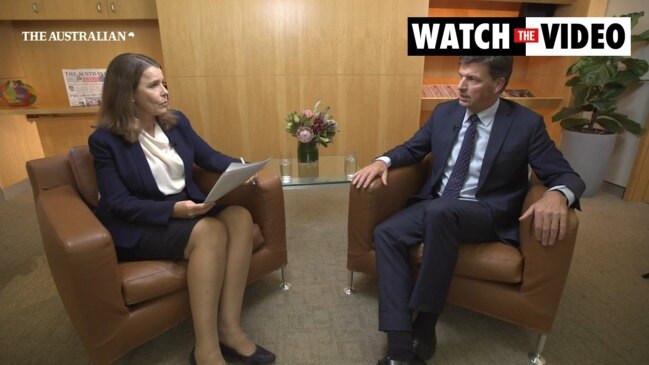Keeping the lights on: power retailers to pay for stability
Energy Minister Angus Taylor discusses the national energy market with The Australian’s business editor at large Ticky Fullerton live at 11.30am AEST.

Coal-fired power stations will be paid for their generation capacity to keep them operating and the government is considering building a new 660MW gas-fired generator in the Hunter Valley in an overhaul of the electricity system aimed at keeping the lights on.
Energy Minister Angus Taylor will on Friday deliver the government’s response to a shortlist of options from the Energy Security Board to redesign the electricity system as the threat to grid security and the economics of coal and gas plants posed by the rapid growth of wind and solar reaches unacceptable levels.
Under the government’s preferred strategy, electricity retailers would pay the owners of dispatchable generators such as coal-fired, gas-fired and hydro plants as well as batteries to guarantee future capacity when the grid is facing periods of peak demand that threatens reliability.
Under current rules, generators are paid on an “energy only’’ basis for the power that is used by consumers. When wind and solar power is operating at full capacity the coal and fuel plants operate at a loss, undermining their economic sustainability.
Mr Taylor insisted that energy prices, which have fallen more than 11 per cent in the past 12 months, will not rise to help pay for increased security.
“The human and financial cost of insecurity is too great to be left unaddressed,” he said.
“We need an electricity grid we can rely on.”
Mr Taylor said the first outcome from the ESB’s recommendations must be the delivery of affordable, reliable power.
“This requires strong market signals that both encourage investment in new dispatchable generation to replace our ageing thermal generator fleet, and incentivise our existing thermal generators to remain in our market for as long as needed,” he said.
Under the proposed capacity pricing retailers like Origin and AGL would pay to have power available, and would need to buy capacity backed by a physical resource to prevent blackouts and brownouts.
These changes would move Australia’s electricity market closer to Britain’s and most of the US. The risk of an energy-only market was laid bare in Texas in February when freezing weather shut down wind and some gas stations and left 4.5 million homes and businesses without power.
Gas is now endorsed by the government as the transition fuel to Australia’s future renewables-powered economy.
“Gas will inevitably provide part of the answer, with prices falling dramatically in the last 18 months, and new generators now typically built to be hydrogen-ready,” Mr Taylor said.
The changes to the system should increase investment certainty for business.
However, there appears little chance of enough new private sector commitment emerging by the government’s Friday deadline to make up the 1000MW shortfall from the closure of the Liddell coal-fired power station in 2023.
EnergyAustralia’s plans for expansion at Tallawarra are progressing. But AGL’s plans for a new quick-fired gas generator at Newcastle are on pause after the NSW government announced its Infrastructure Roadmap which favoured new energy projects.
Tallawarra on its own could only supply 300MW and the Andrew Forrest-backed Squadron Energy gas and hydrogen power station is not expected to meet the time frame. All signs point to the government building a 660MW gas generator in the Hunter.
The government at all cost wants to avoid a shock where coal-fired power stations, providing 66 per cent of electricity in the NEM, are killed off years ahead of their planned closures.
“Shutting our coal rapidly and the trifecta of affordable, reliable and sustainable electricity will be lost. That is why it is important that existing coal generators are kept in our system until dispatchable replacement capacity is in place,” Mr Taylor said.
The government is also considering an Essential System Service where dispatchable power companies will be paid by the Energy Market Operator for additional capacity to stabilise frequency and voltage across the electricity grid.
ESB chair Dr Kerry Schott warned the scale and pace of change occurring across the National Electricity Market could not be overstated.
According to the ESB, in the next two decades, 39-74 gigawatts of renewable energy from wind to rooftop solar is forecast to enter the system.
‘‘This means there is a need for 6-19GW of new flexible and dispatchable resources, as up to 63 per cent of the current coal and gas fleet in the NEM retires by 2040,’’ it says.
While the ESB had already introduced a Retailer Reliability Obligation, its operation has not been strong enough to encourage more investment in firm capacity into the market.




To join the conversation, please log in. Don't have an account? Register
Join the conversation, you are commenting as Logout